Diversification
The act of spreading investments amongst different assets, companies, and sectors.
What Is Diversification?
Diversification refers to the practice of extending the range of products or investments to limit systematic exposure to one specific asset or product. It is a risk management strategy.

It reduces the concentration of capital on a single company or product. If an investor or manager monitors only one asset's movement, all their risks and rewards depend on that asset.
When the asset has high growth, the manager and investor benefit from the profits. However, seasonality and other business risks could also affect the asset, potentially resulting in a loss.
One can avoid the loss by investing in diversified tools (primarily for investors) or diversifying the portfolio by including a variety of assets. A positive return on one asset can offset a negative return on another.
Essentially, diversification means expanding horizons. The leading question about diversification is whether to diversify or not. It requires careful consideration and balancing of the risks and rewards involved.

Managers can use diversification to include a range of products in their revenue segments. It can be viewed as an opportunity for development rather than a risk management strategy for a business.
Similarly, investors can diversify their investments across asset classes to reduce portfolio risk. A portfolio, by definition, relates to a collection of investments. Investors who invest in diversified tools create a portfolio and must rebalance it when required.
This article will explain diversification from a business and investor perspective.
Key Takeaways
- Business diversification refers to including new revenue-generating segments in the product portfolio.
- A business can either diversify by introducing new products and markets in its portfolio or merge with other companies to utilize their production facilities.
- There are three product diversification strategies - horizontal, concentric, and conglomerate.
- For an investor, diversification refers to extending your range of products or investments to limit your systematic exposure to one specific asset or product.
- The significance of diversification is that it can considerably reduce portfolio risk.
Diversification for Businesses
Business diversification refers to including new revenue-generating segments in the product portfolio. It allows a company to tap into new markets and, in turn, improve its market position through growth.

It assists in increasing the customer base and scope of business. It is a highly used growth strategy whereby more prominent companies have grown, and surviving companies have reached newer heights.
Before forming a strategy, a manager must compute an internal analysis to understand whether the business can sustain an expansion. An internal analysis entails a clear understanding of the strengths and weaknesses of the company.
By doing so, a manager can understand whether they have the necessary technical and financial feasibility to expand their business.
Note
The technical feasibility focuses on whether the existing resources, especially technology, can support their growth strategy.
A financial feasibility analysis examines not only the current financial situation of the company but also the overall financial requirements for the new product, including any future expenses.
After conducting these two steps, a manager must decide based on the project's riskiness. It is important to remember that diversification is a strategy that reduces risk but does not eliminate it entirely.

It is easier for more prominent companies to expand to a new market as they can sustain losses if a product does not sell. For example, a world-famous magazine, Cosmopolitan, introduced Cosmopolitan yogurt, which was seen as a significant market failure.
Advancing from a media company to a dairy product did not make sense to many consumers. Furthermore, the yogurt prices were above the average market prices. This caused a further negative sentiment among buyers, and Cosmopolitan had to relinquish the product.
The example of Cosmopolitan highlights the importance of careful market research, understanding consumer preferences, and aligning diversification efforts with the company's core competencies and brand image.
Business Strategies
There are several strategies that managers can employ to diversify their businesses.
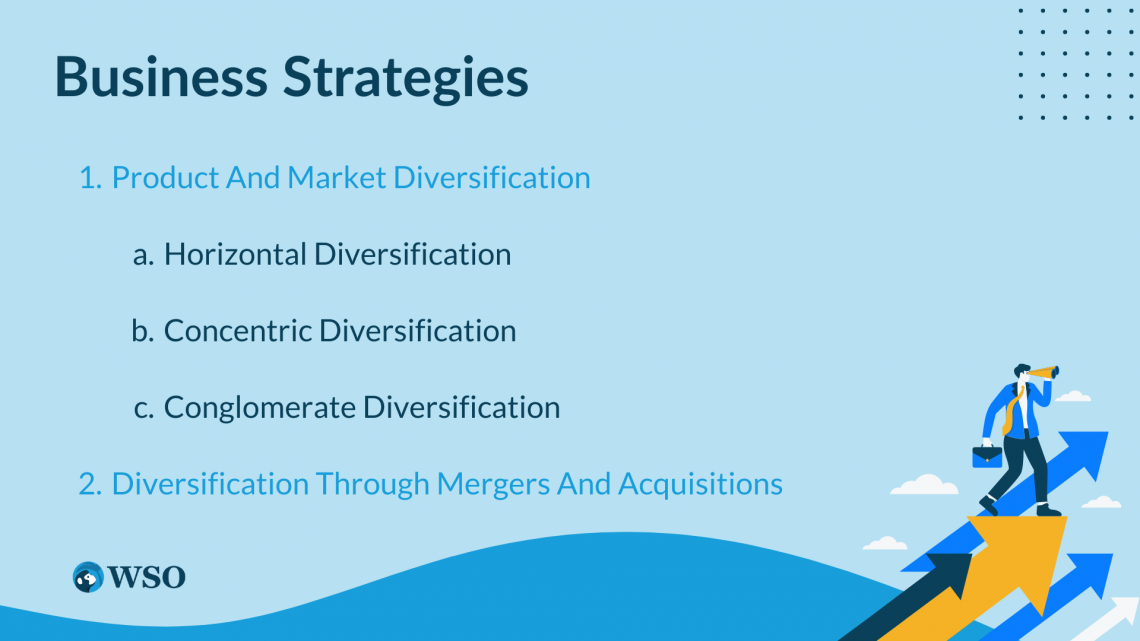
Two common strategies are:
1. Product And Market Diversification
A business has diversified revenue segments when they have more product and service lines that require different information systems and capital expenditures. A company can tap into new markets and increase its sales by expanding to new product lines.
As the sales increase, the business could be more profitable. Usually, companies try to expand their product lines after gaining a substantial market share for their existing lines.
The various strategies that a business could engage in are:
a. Horizontal Diversification
This technique involves adding products similar to the existing lines and should be related to the same industry.
Example
Facebook’s (Meta) acquisition of Instagram is a horizontal expansion as they both engage in social media
b. Concentric Diversification
This technique involves expanding the range of products to attract more customers.
Example
The most famous example is PepsiCo’s acquisition of Pizza Hut, Taco Bell, and KFC.
c. Conglomerate Diversification
In this technique, the business adds a product line from a different industry that is not similar to any existing line.
Example
Procter & Gamble (P&G) is a multinational conglomerate focusing on personal care, health, and hygiene products.
2. Diversification Through Mergers And Acquisitions
Mergers and acquisitions provide opportunities for businesses to diversify by adding existing product lines or consolidating with other companies.
With the completion of an M&A, the parent company enjoys the benefits created by the subsidiary, which has specialized in its separate product lines. Thus, an M&A aids in increasing the revenue streams without the hassle of research & development, promotion, and other fees.
Instead of an M&A, a manager can also opt for a joint venture, wherein a strong alliance is created to supply and produce a new product.
Example
BMW and Brilliance Auto Group co-joined so that BMW could take advantage of Brilliance’s manufacturing plants in China.
Advantages Of Business Diversification
3M completed the most well-known successful diversification and has been crowned the title of a Dividend King. A company is considered a dividend king when it consistently increases its dividend payouts for 50 consecutive years.

3M is a conglomerate with industrial, safety and graphics, health care, electricity and energy, and consumer goods business segments.
In 2017, after diversifying, the overall sales were $32 Billion, a 5.1% growth since 2016. All revenue segments experienced considerable growth. From this, we can comprehend that the benefits of diversification are endless if executed correctly.
Let us understand the specific advantages of investing in diversification.
1. More Customers And Demand
When a business enters new markets, the number of customers increases, creating demand through newer opportunities.
Note
The company can thrive in the new market if its new products are of superior quality and are competitively priced.
With the new demand, the business can also secure a new income source that can provide them with stability and helps increase the business's profitability and growth.
2. Economy Of Scope
Especially for horizontal and concentric diversification, the companies can achieve an economy of scope by producing products similar to their existing lines.
Note
The economy of scope is the advantage received when a company produces similar products, where their average cost decreases.
3. Boosting Brand Name
Improving one’s brand name is the topmost criterion for many companies. With diversification, more customers could access the products creating superior brand recognition.
Moreover, customers prefer to buy the products of companies they know or have heard of. When a trustworthy business expands into a product line for the same industry, customers prefer to buy their product leading to increased brand recognition.
Disadvantages Of Business Diversification
The disadvantages of diversifying a business are discussed below.
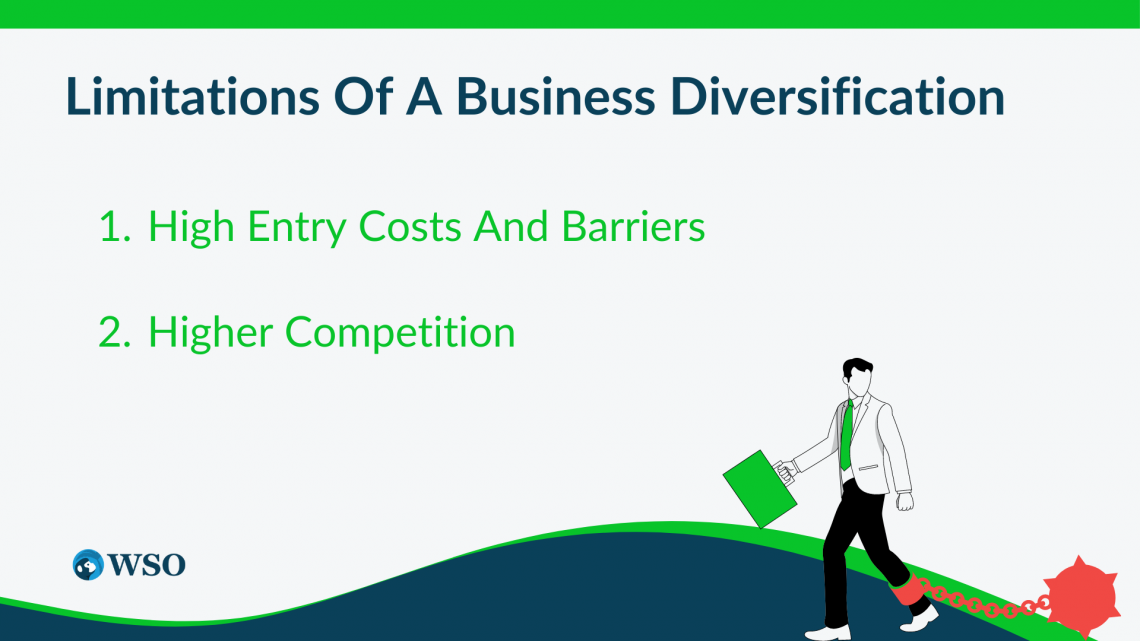
1. High Entry Costs And Barriers
The costs and risks of diversifying into a new industry or producing new products are significant. The company would need substantial disposable capital for such an expansion.
Furthermore, this move could prove risky since the business does not entirely understand how the new market operates.
Note
Despite the risks and entry barriers, there is uncertainty about whether the product will sell and generate profits.
2. Higher Competition
Every existing market and industry has a leader holding a substantial market share. A company must understand the competitor's strength before expanding. For a product to be successful, it must be such that customers will want to purchase it.
Using a strategy for cost leadership and product differentiation could strengthen their market position. However, this requires significant Research & Development (R&D) and technology spending.
Diversification for Investors
Investors should continuously diversify their capital across investments so they do not become victims of a specific company’s risk. Although diversification is a recommended technique, it is a cumbersome tool.

Investors must diversify based on their risk tolerance, i.e., the amount of risk an investor is willing to undertake. When an investor diversifies across various financial instruments and industries, they reduce the overall risk that the portfolio will face.
The portfolio weightage, or the allocated amount for an instrument, varies per the investor's sentiments. Some analysts recommend using a 60/40 technique, wherein 60% is allocated to stocks and 40% to fixed-income securities.
Diversification continues even after investments are quantified and spread across multiple sectors initially. It is a continuous process that requires rebalancing whenever required. The frequency of rebalancing depends on the investor and their risk appetite.
Note
The significance of diversification is that it can considerably reduce portfolio risk. However, the elimination of every risk is never possible. The reason behind this is very technical.
Two risks - systematic and unsystematic, can influence a portfolio. Systematic or non-diversifiable risk is the risk that will affect the whole market and not just an individual stock. On the other hand, unsystematic or diversifiable risk only shocks a particular stock or industry.
The systematic risk is not controllable. For example, COVID-19 was unprecedented, with worldwide repercussions affecting every market and every individual's portfolio. It is not usually predictable, which makes it much harder to control.
Unsystematic risk arises from the company or industry itself. This risk is diversifiable as it can be predicted and controlled.
Note
Investors can use the ‘beta’ to estimate the stock's unsystematic risk as it measures the company’s volatility.
The unsystematic risk that can affect a company is listed below:
- Business risk
- Financial risk
- Default risk
- Liquidity risk
Investing Strategies
There are multiple strategies that an investor could utilize to construct a well-diversified portfolio. These strategies can be used separately or as a combination.
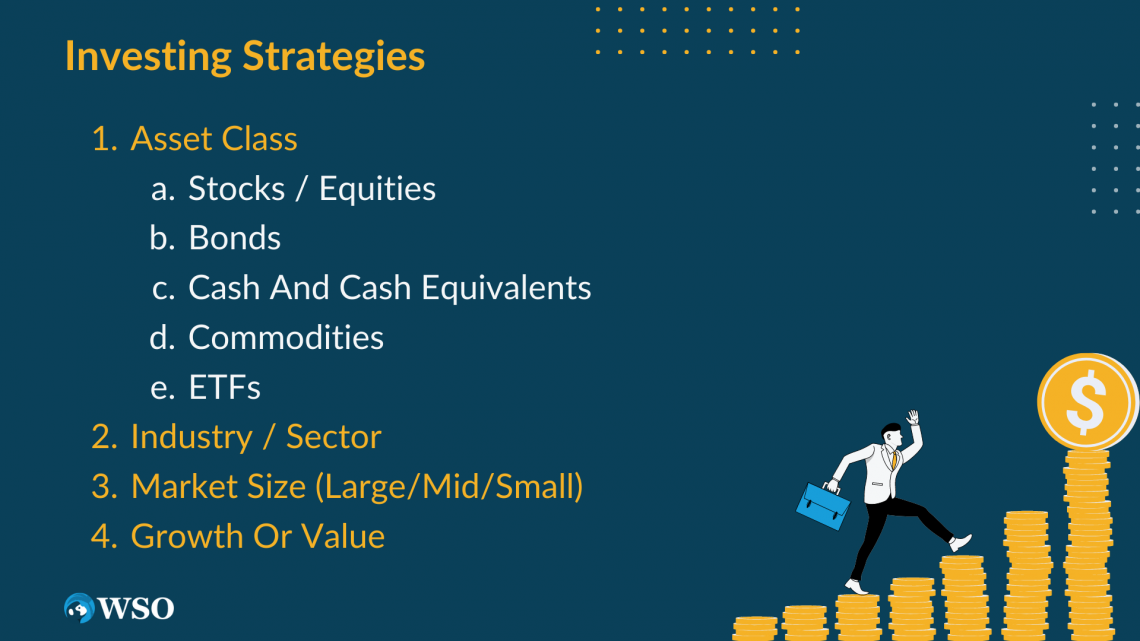
1. Asset Class
Various asset classes can be used for investment purposes. They are listed below, along with a description of each. When an investor diversifies their investments across multiple asset classes, they safeguard their portfolio from market risks.
a. Stocks / Equities
A stock is a part of the company’s capital distributed to the public so they can raise additional funds. An investor who purchases a company share is known as a shareholder.
Note
Stocks are volatile investments but are the most popular type of investment class.
b. Bonds
Bonds are debt instruments that corporations, as well as governments, can issue. In a bond contract, an investor lends money to the government or corporation that returns it on a specified date. A bond is steadier than a stock, indicating a fixed income receivable as interest payments.
These low-risk securities are liquid cash, usually representing bank or deposit accounts.
Note
Cash equivalents are securities easily converted to cash, including Treasury Bills (T-bills) and other money market funds (short-term maturities).
d. Commodities
These tangible goods are usually traded to hedge the effects of inflation. Generally traded commodities include metals (gold, silver), energy, livestock, and agriculture. The prices of commodities are set based on supply and demand, which is unique to the commodity market.
e. ETFs
Exchange Trade Funds (ETFs) are the most diversified tool an investor can utilize as it holds multiple asset classes within themselves.
2. Industry / Sector
An investor can alternatively invest in different stocks belonging to diversified industries. The Global Industry Classification Standard (GICS) broadly classifies stocks based on the following market sectors.
- Consumer Discretionary
- Consumer Staples
- Communication Services
- Energy
- Financials
- Healthcare
- Industrials
- Information Technology
- Materials
- Real Estate
- Utilities
An investor can avoid the risk of a particular industry by investing in negatively correlated companies.
Note
When the movements of two separate sectors are generally opposite, they are typically regarded as negatively correlated.
Diversifying across sectors allows investors to take advantage of various economic cycles and market trends.
3. Market Size (Large/Mid/Small)
An investor could pool their capital based on the company's relative size. Its market capitalization measures this by multiplying the outstanding shares with the current market price.
A company is ranked based on market capitalization and placed in the following categories:
- Micro-cap: market capitalization < $300 million
- Small-cap: $300 million < market capitalization > $2 billion
- Mid-cap: $2 billion < market capitalization > $10 billion
- Large-cap: $10 billion < market capitalization > $200 billion
- Mega-cap: $200 billion > market capitalization
Companies included in the micro and small capitalization categories are said to be riskier than the rest. They have much more growth opportunities but own fewer resources than a mid or large-capitalization company.
Note
Allocating investments across market sizes can provide a balance between risk and potential returns.
4. Growth Or Value
Investors can diversify their portfolios by investing in growth or value stocks.
Growth stocks are associated with companies with high growth potential and investing in innovative opportunities, while value stocks are undervalued companies with stable fundamentals.
Combining growth and value stocks can help diversify risk and capture different investment opportunities.
Advantages Of Diversification In Investing
Investing is a risky strategy; however, it is an excellent way for individuals to earn extra income. All investors are encouraged to diversify to avoid company-specific risks.
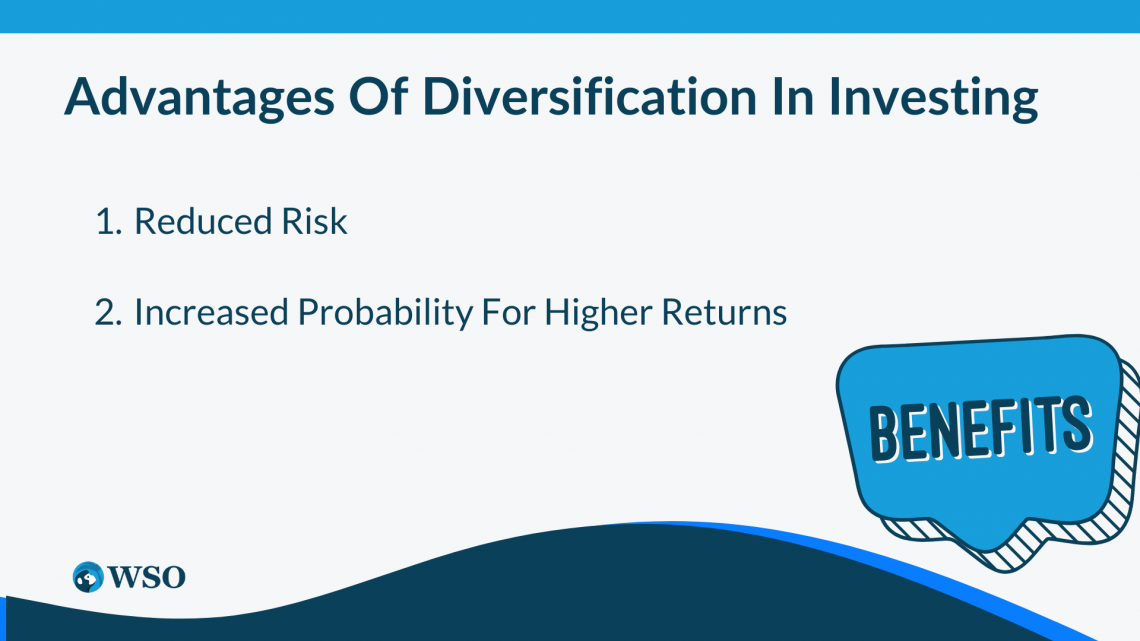
Here are the advantages of diversifying your investments.
1. Reduced Risk
The primary reason for diversification is to avoid systematic risks. A rise in another can offset the risk of loss from one stock. In this way, investors could benefit from the overall portfolio value.
For example, if an investor does not employ the diversification strategy and invests all their capital in one stock, their return highly depends on just one company. This is risky as a sudden plunge in the value would create a heavy loss.
Note
If the investor had proportioned their capital across companies negatively correlated with the first company, they could increase their chances of profit.
2. Increased Probability For Higher Returns
Diversifying portfolios allows investors to optimize risk-reward ratios. By allocating investments across different asset classes or securities, investors can benefit from potential returns in various market conditions.
A well-diversified portfolio should have virtually little to no systematic risk.
Example
Combining stocks and bonds in a portfolio can provide both growth potential from stocks and income stability from bonds.
By doing so, the investor immunizes their returns during a market downturn, as they would still earn through the interest receivable on bonds. Similarly, during a market upside, the investor would receive a higher return from the stocks and bonds.
Disadvantages Of Diversification In Investing
Some disadvantages of diversifying are:
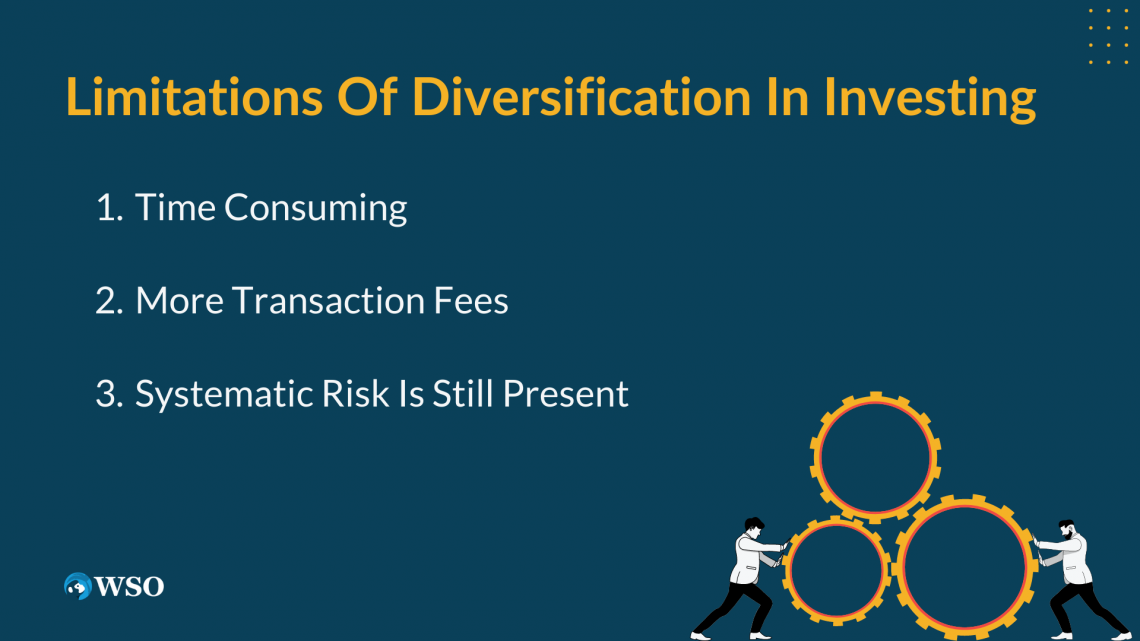
1. Time Consuming
Constructing a well-diversified portfolio requires research and understanding of different asset classes, industries, and investment options. Furthermore, this strategy is difficult for an investor without a financial background and expertise.
Even if an investor chooses a strategy whereby they only invest in stocks of different industries, it still requires concise judgment using historical data before they can finalize the selected stocks. This is time-consuming, especially for individuals looking for a second income.
Note
It is time-consuming to rebalance the portfolio constantly.
2. More Transaction Fees
As more investments are to be bought, the investor would incur more transaction fees than buying only one asset.
3. Systematic Risk Is Still Present
Although an investor can never anticipate systematic risk, it is still considered a significant risk factor. The most well-diversified portfolio would always be a victim of systematic risk as it affects the whole market.




or Want to Sign up with your social account?